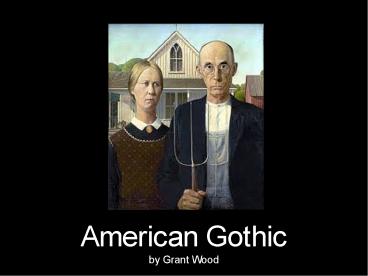American Gothic by Grant Wood - PowerPoint PPT Presentation
Title:
American Gothic by Grant Wood
Description:
American Gothic by Grant Wood Though in many of its aspects this visible world seems formed in love, the invisible spheres were formed in fright. – PowerPoint PPT presentation
Number of Views:440
Avg rating:3.0/5.0
Title: American Gothic by Grant Wood
1
American Gothic by Grant Wood
2
Though in many of its aspects this visible world
seems formed in love, the invisible spheres were
formed in fright.Herman Melville (in Moby Dick)
3
What is Gothic?
- The name gothic actually comes from the
architectural style of the Middle Ages. The
irregular style, lack of symmetry, grotesque
gargoyles and angular shapes are characteristics
of this type of architecture.
4
Gothic Grew Out of
- The gothic grew out of
Romanticism, which was a
response to the Rationalist
Movement. - As the romantics felt free
from logic, they were free
to explore imagination, including the darkest
side of it. - In a way, you could say the original romantics
explored beautiful dreams, whereas the gothic
writers explored nightmares.
5
Romanticism Emphasizes
- the beauty and purity of nature
- emotion over reason
- belief in the natural goodness of man
- belief that nature and simplicity purity
- cities and sophistication corruption
- belief in The 5 Is- Imagination, Intuition,
Innocence, Inner Experience, and Inspiration from
nature/supernatural
6
The Dark Romantics
- When romantics saw individualism, they saw
hope, vitality, a new way! - Gothic writers looked at the individual, and saw
the potential for evil they saw darkness.
7
Beauty and Horror
- While romantics were looking at the beauty of
nature gothic writers were envisioning the dark
and scary forests and all the horrors, natural
and supernatural, hidden within.
8
The Masters
- By the 19th century, gothic elements had taken
over the work of Edgar Allan Poe (considered the
American master of the genre), Nathaniel
Hawthorne (who had ties to the Salem witch
trials), Washington Irving (The Legend of Sleepy
Hollow) and, in a more subtle way, Hermann
Melville (Moby Dick). Gothic elements are also
noticeable in Emily Dickinsons poetry. - The gothic tradition continued in the 20th
century with authors like William Faulkner,
Flannery OConnor.
9
Authors Distincitve Approaches
- As one can glean from the painting American
Gothic, the horror of the mystery, horror, even
terror of the genre is often subtly conveyed. - Authors have applied unique styles to crafting
gothic literature and conveying what really is
horrific. - Hawthorne is different from Poe, for instance.
Whereas Poe focused on the darkness of the mind,
Hawthorne focused on the darkness of the soul and
the human heart vanity, betrayal, mistrust,
hatred, etc.
10
Lets Consider
- Life in Salemhard to relate
- Life in Victorian erahard to relate in some
ways - Outlook
- Art/Values
- For example
11
How Life Imitates Art
12
(No Transcript)
13
(No Transcript)
14
(No Transcript)
15
(No Transcript)
16
(No Transcript)
17
Inheritance
- The power of the gothic tradition hasn't really
waned in all these years. - Anne Rice's 1973 novel 'Interview with the
vampire' and particularly its film adaptation
(1994) revitalized the genre for newer
generations.
18
Inheritance
- Today, we have Stephanie Meyer's glittery high
school vampires, the works of Neil Gaiman
(Coraline) and the films of Tim Burton (Sleepy
Hollow, The Nightmare Before Christmas, The
Corpse Bride), all feeding from a strong literary
tradition. - As life imitates art, we have social groups
derived from this art form the Goths (the kids
with eyeliner, not the East Germanic tribe).
19
- What scares YOU?




















![NOTE: To appreciate this presentation [and insure that it is not a mess], you need Microsoft fonts: PowerPoint PPT Presentation](https://s3.amazonaws.com/images.powershow.com/5420324.th0.jpg?_=20200904124)










